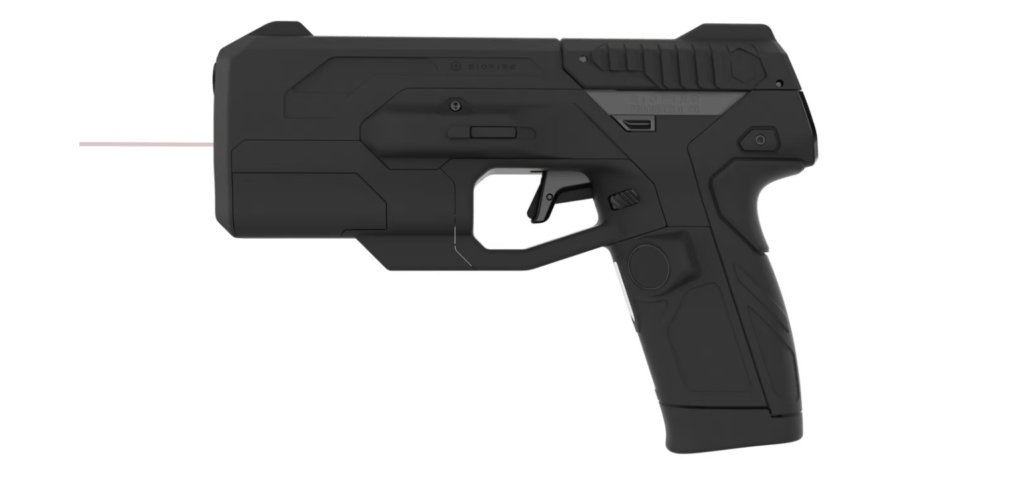Biometric safety is going to become a big thing in the firearms industry. It’s just a question of when that happens.
Biofire has brought us the first prototype and is taking orders for the first gun with a biometric lock. It won’t be the last…
While the technology seems inevitable, there are a number of concerns and hurdles in the way of mass adoption. So where are we at with biometric locks for guns? And what does the future hold?

Biofire Smart Gun: The First Biometric Handgun
The Biofire Smart Gun is a pioneer in the field and early impressions have been positive. It’s a fire by wire system with what it claims is defense grade encryption, It also comes with an onboard laser and warning lights that can be disabled or altered by the user and then saved as settings that automatically deply when the user picks up the gun.
It disables in milliseconds after you release the gun and simply will not work for an unauthorised user.
There’s a lot to like here, but at 2.4lb unloaded it’s a hefty chunk of plastic, metal and tech. It’s really too heavy for an EDC. There’s also the small matter of the price, $1,499 to be exact.
It’s a step in the right direction and a major moment for the firearms industry, But the Biofire might be for early adopters, rather than the general population.
Understanding Biometric Technology in Firearms
Biometric technology refers to the identification and verification of individuals based on biological and physical characteristics. In the context of firearms, biometric safety features typically involve fingerprint recognition, though other biometric markers like retinal scans or facial recognition are also being explored.
Biometric locks on guns typically use fingerprint scanners to unlock the firing mechanism. When an authorized user grips the gun, the scanner reads the fingerprint and, if it matches the stored profile, the gun is unlocked and ready to fire.
Benefits of Biometric Safety Features
1. Preventing Unauthorized Use
The primary advantage of biometric locks is the prevention of unauthorized use. This feature is particularly important in preventing accidents, especially involving children, or in case a firearm is stolen.
Biometric gun safes have started to gain widespread acceptance, but these allow for simpler and larger mechanisms, and don’t take the same abuse that a concealed carry handgun must endure.
2. Quick Access for Authorized Users
Unlike traditional safes or locks that might require keys or combinations, biometric systems can allow for quicker access. This can be crucial in self-defense situations where time is critical.
3. Personalization
Biometric systems allow for personalization of firearms. Multiple users can be authorized for a single firearm, each with their unique biometric data stored. The Biofire has basic settings, but in the future everything from the strength of the trigger pull to the illumination on the red dot sight could be pre-dialled for a number of different users.
Problems and Concerns
While biometric safety features offer several benefits, they also come with challenges that need addressing.
1. Reliability and Technical Failures
One of the main concerns with biometric guns is their reliability. Issues such as dirty fingers, low battery, or sensor malfunction can prevent the gun from firing, which could be detrimental in a self-defense situation.
2. Cost and Accessibility
Biometric guns are typically more expensive than traditional firearms due to the advanced technology involved. This cost factor could be a barrier for many potential gun owners.
3. Emergency Situations
In an emergency, a biometric gun can only be used by an authorized person. If the authorized user is incapacitated, others can’t use the gun for defense. That could pose a significant risk in certain scenarios.
The Technology Behind Biometric Guns
The technology in biometric guns involves advanced sensors, microprocessors, and software algorithms. The sensors must be highly sensitive and accurate to ensure they work under various conditions.
Even a miniscule failure rate just isn’t good enough. Because when your life is on the line, nothing less than an instant response is good enough.
Upgrades and Maintenance
Like any technology, biometric systems in guns require regular upgrades and maintenance. This includes software updates, battery replacements, and sensor cleaning to ensure optimal performance.
In short your handgun will be full of computer tech, which is notoriously fragile and prone to breaking with age. Those are issues that the industry will have to deal with before the public truly accepts biometric access guns.
Integration with Smart Gun Technology
Biometric safety features are often part of broader smart gun technology, which might include other features like RFID chips, electronic triggers, and even tracking capabilities, black box data and video recording of any incident.
Smart Gun Legislation
The rise of smart guns has led to legislative discussions in various regions. Some laws propose to mandate smart gun technology, while others focus on regulating its development and use.
Impact on Law Enforcement and Military
The adoption of biometric guns in law enforcement and the military presents both opportunities and challenges. While enhancing gun safety, questions about reliability in diverse environmental conditions and combat situations remain a concern.
Eventually they will have to take the first step if they want to introduce biometrics for the public. I mean if it’s not safe for the cops, it’s not safe for us either right?
Training and Adaptation
For gun enthusiasts, adapting to biometric guns involves training and familiarization. Understanding how to operate and troubleshoot these guns is crucial, especially since they differ significantly from traditional firearms.
Future Developments and Potential
The future of biometric gun technology holds significant potential. With advancements in sensor technology, AI, and battery life, biometric guns are expected to become more reliable and user-friendly.
FAQ: Biometric Safety Features in Guns
1. How reliable are biometric safety features in guns?
The reliability of biometric safety features can vary. While modern sensors are generally accurate, they can still face issues like failure to read a fingerprint due to dirt, moisture, or sensor damage. Continuous technological improvements aim to address these reliability concerns.
2. Can biometric guns be used in emergency situations by someone other than the owner?
In most designs, biometric guns can only be used by individuals whose biometric data is registered with the firearm. This could be a limitation in emergencies where the registered user is incapacitated, and someone else needs to use the gun.
3. Are biometric guns more expensive than traditional firearms?
Yes, due to the advanced technology involved, biometric guns are generally more expensive than traditional firearms. This cost includes the biometric sensor, processing unit, and software integration.
4. What happens if the biometric sensor on a gun fails?
If the biometric sensor fails, the firearm will not unlock, rendering it inoperable. This is a significant concern for reliability, especially in self-defense scenarios. Some models may have override options, but this varies by design.
5. Is there resistance to the adoption of biometric gun technology?
Yes, there is some resistance to biometric gun technology, primarily due to concerns over reliability, cost, and potential government regulation. Additionally, some gun owners prefer the simplicity and proven reliability of traditional firearms.


